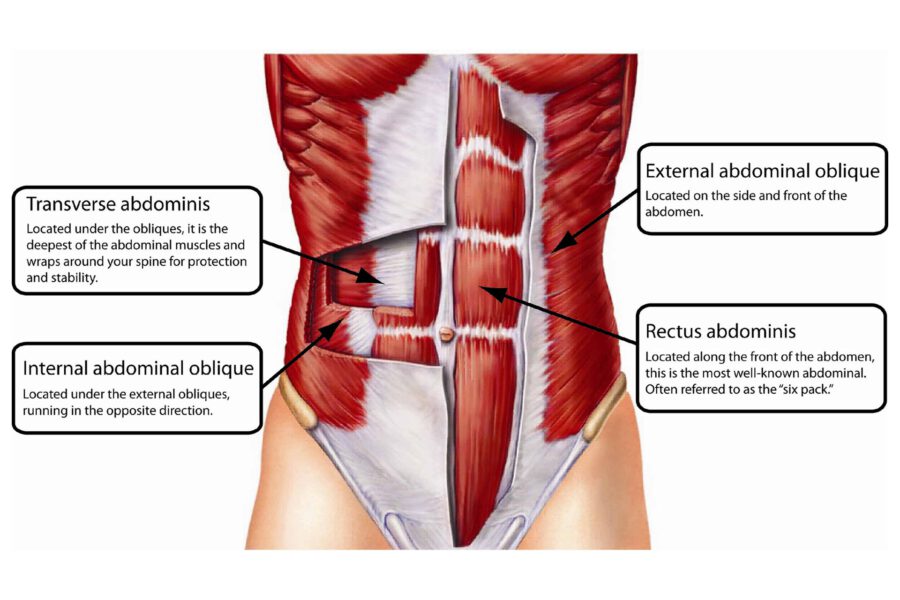Deep Core Exercises: How to Build Injury Protection Muscles
Sculpting a body you can be proud of is not the only goal of grinding in the gym and staying consistent with your fitness routine. Above all else, exercise trains your body to be stronger, protect yourself from injuries and delay the effects of aging.
Nothing beats well-developed deep core muscles when it comes to staying healthy and injury-free. This is because the deepest layers of your abdomen are crucial in maintaining a healthy posture and providing better balance and stability, which results in overall efficiency in physical performance and harmonious movements.
Unfortunately, the deep core muscles are one of the most neglected muscles in the body. Some may even develop weak core muscles despite having 8 pack abs. When these muscles are underactive or hyper-engaged, pain and dysfunction can occur.
This article will dive deep into the science of deep core muscles and how you can strengthen them by performing quick and easy exercise routines.
The deep core muscles include the transversus abdominis, pelvic floor, diaphragm, and multifidus muscle. They stabilize the trunk while the arms and legs move during functional movements.
These muscles must work harmoniously to achieve optimal balance and stability in daily activities and intense physical performance such as high-intensity exercises or sports.
The transversus abdominis (TA), in particular, extends from your lower ribs to the top of your pelvis and wraps around your abdomen, forming a built-in back brace, providing critical support for your entire body.
It is like a corset that keeps everything in your belly area "tight" and "tucked in."
Contrary to popular belief, having a six-pack abs doesn't ensure that you have a strong core. Superficial muscles form the six-pack and separate from your deep core.
Therefore you can have good-looking abs but still have weak core muscles since you cannot strengthen the deep abs by doing regular sit-ups.
Weak core muscles can lead to spinal dysfunctions, increased spinal disc wear and tear, and pain. Fortunately, you can efficiently train your core to engage and develop sufficient strength by doing simple but effective exercises and body movements.
Aside from developing core strength and improving stability, here are the other benefits of performing deep core exercises:
When you engage your deep core muscles, you're essentially working the muscle layers that act like a natural corset for your midsection. Consistent training can help tighten and tone the abdominal muscles, contributing to a sleeker and more toned stomach appearance.
Studies have shown that strengthening the deep core muscles can lessen lower back pain symptoms. This is because optimal core strength can make physical activities easier and safer by stabilizing the lumbar spine or lower back during movement.
In addition, strengthening and activating your transversus abdominis can help activate other deep muscles, such as the multifidus, which lead to better spinal support.
Activating and engaging your transversus abdominis can help reduce your waistline due to greater activation of the midsection muscles and keep them tight. Proper strength and activation of the TA are crucial in maintaining normal abdominal wall tension and pressure, which support your internal organ.
Ultimately, this results in a smaller waistline and further enhancement of the visual effect of an hourglass body or V-taper physique.
A strong deep core can significantly influence your posture and alignment. They can help align your spine and reduce slouching or hunching due to exhausted spinal muscles.
This is critical to maintaining your confidence and attractive appearance and facilitates better breathing and circulation, further enhancing your health and wellness.
Keeping your deep core engaged can help protect your back from lifting injuries from heavy compound movements like deadlifts or squats.
An unstable spine and weak core can cause sudden and awkward positioning of the spinal disc, which can lead to nerve impingement and spinal injuries when lifting heavy objects.
Activating the transversus abdominis is essential before performing core workouts. By performing abdominal activation, you are essentially improving your mind-muscle connection and enhancing the efficiency of your activities.
How to do it:
- Lie on your back and bend your knees
- Place your fingers on top of your hip bone and move them 2cm inward and down to feel the contraction of the TA
- Take a deep breath in and slowly breathe out
- As you breathe out, engage or contract your core muscles by drawing your belly button up and toward your spine
- Hold the position for 6 seconds while breathing normally, then relax.
- Repeat 10 times
Plank
The plank exercise is one of the most effective core exercises. Keep your stomach tucked in when performing this movement by engaging your deep core throughout the exercise.
How to do it:
- Assume a push-up position with your elbows and forearms propped against the floor.
- Push off the floor and rest on your elbows, creating a ‘bridge’ in between your toes and elbows.
- Keep your back flat and engage your core by drawing in your belly button towards your spine
- Don't hold your breath. Breathe normally
- Hold this position for 30 to 60 seconds
- Repeat for 3 to 5 times
Bear plank is basically a next-level plank exercise where you can better engage your core muscles by maximizing their range of motion.
How to do it:
- Assume a tabletop position on all fours
- Keep your hands aligned with your shoulders, knees under your hips, and maintain a neutral spine
- While engaging your core, push your palms into the floor and lift your knees just barely off the ground.
- Avoid arching your spine
- Hold this position for 30 to 60 seconds
- Relax and return to the starting position
- Repeat for 3 to 5 times
Toe taps are a low-impact exercise that targets the lower abdomen and a popular wall pilates move.
How to do it:
- Lie on your back so your knees are directly above your hips
- Bend your knees at 90 degrees
- Keep your core engaged, slowly lower your left foot, and tap the floor with your toes while keeping your right knee bent
- Return to the starting position and do it on the opposite side
- Do this for 10-15 reps on each side
Here’s a women’s plan you should try if you want to build a deep core:
And for men:
The deep core muscles are activated during arm and leg movements. The bird dog exercise challenges the core muscles, requiring you to lift the opposite arm and leg simultaneously while maintaining proper balance.
How to do it:
- Start on all fours
- Align your knees with your hips and your hands under your shoulders
- Assume a neutral spine by keeping your back and neck flat in a neutral position
- Extend your right arm forward while moving your left leg back
- Hold for 2-3 seconds while engaging your core
- Do it on the opposite side
- Repeat 10 times
The dead bug is similar to the bird-dog exercise, but it eliminates the requirement for good balance. This exercise is excellent for people with problems maintaining stability or compromising balance and proper posture during core workouts.
How to do it:
- Lie flat on your back
- Keep your arms extended up pointing towards the ceiling
- Assume a 90-90 knees bent position
- Engage your core while lowering your right arm to reach behind your head and straightening your left leg towards the floor. Don't let your arms or legs touch the floor
- Return to the starting position and do it on the opposite side
- Repeat 10 times on each side
Achieving your dream physique is just one of the many benefits of developing strong deep core muscles. Your deep core muscle, such as the transversus abdominis, keeps your spine stable and promotes healthy posture.
Including the exercises listed above in your core workout routine ensures that you are developing not only your superficial abdominal muscles but also your deep core muscles.

